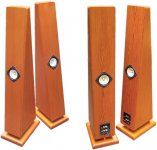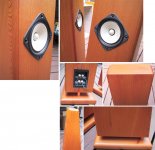In return for a few speaker drivers (so that he can himself build a pair of speakers), a local woodworking expert will be building me a pair of speaker cabinets.
While MDF is quite popular, some hardwoods are not so expensive as to be out-of-reach. A local lumberyard has bloodwood pretty cheaply, and I must say, it does look very attractive.
Is this a good or bad choice?
While MDF is quite popular, some hardwoods are not so expensive as to be out-of-reach. A local lumberyard has bloodwood pretty cheaply, and I must say, it does look very attractive.
Is this a good or bad choice?
Yeah, solid timber glued to hardwood is always a good choice. Mind you I tend to the box whole timber and MDF bar leave the front baffle MDF and give it a good paint gloss black. But hey, I just like it that way. 15mm MDF & 12mm+ hardwood on the outside is always a good compromise in price and strength so to speak so I have found.
Ostie01 is quite right, no matter what you do, hardwood will always expand when absorbing moisture with humid conditions and conversely, shrink when it is dry. This occurs with greater range in Canada than perhaps in drier Australia however. Another approach involves allowing the wood baffle to move independent of the mdf cabinet.
A batten can be applied around the outer edge of the cabinet front mdf inner baffle in the species of wood from which the outer baffle will be constructed. This batten can be .75 to 1" wide and .375" thick. I roundover mine with a .375" bit. Construct the baffle with your hardwood so that it will be .25" smaller than the outer dimensions of the box. Then rabbet the back of the hardwood baffle a little less than .375" deep and make the rabbet about .125" wider than the batten.
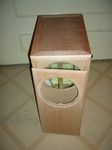 Click for larger picture
Click for larger picture
This will allow the hardwood baffle to drop inside the batten but not quite touch the mdf baffle. But there will be a .125" gap around the baffle which will allow the hardwood to expand and contract. When the driver cutouts and rabbets have been completed, in both the inner and outer baffles, the hardwood baffle is glued to the mdf using green NoMoreNails. This has some flexibility and will allow the baffle to move. This works on a baffle up to 12" wide.
Try to use quartersawn hardwood (it expands and contracts the least). Quartersawn lumber has straight grain lines, not the cathedral pattern that is more common with lumber which is called flatsawn.
Here is a picture of the inset baffle on a speaker that I have done.
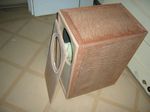 Click for larger picture
Click for larger picture
In this baffle, the cherry is only .375" thick, but it is glued to a baltic birch ply which is also .375" thick. Although it is glued with PVA, the thinner board should be less prone to break the glue bond with the ply. You can see the ply on the scalloped cutout. But I have used this method with a full .75" hardwood baffle and it still is intact after 3 years of dry winter and humid Great Lake summers.
Finished speaker picture:
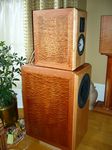 Click for larger picture
Click for larger picture
A batten can be applied around the outer edge of the cabinet front mdf inner baffle in the species of wood from which the outer baffle will be constructed. This batten can be .75 to 1" wide and .375" thick. I roundover mine with a .375" bit. Construct the baffle with your hardwood so that it will be .25" smaller than the outer dimensions of the box. Then rabbet the back of the hardwood baffle a little less than .375" deep and make the rabbet about .125" wider than the batten.
This will allow the hardwood baffle to drop inside the batten but not quite touch the mdf baffle. But there will be a .125" gap around the baffle which will allow the hardwood to expand and contract. When the driver cutouts and rabbets have been completed, in both the inner and outer baffles, the hardwood baffle is glued to the mdf using green NoMoreNails. This has some flexibility and will allow the baffle to move. This works on a baffle up to 12" wide.
Try to use quartersawn hardwood (it expands and contracts the least). Quartersawn lumber has straight grain lines, not the cathedral pattern that is more common with lumber which is called flatsawn.
Here is a picture of the inset baffle on a speaker that I have done.
In this baffle, the cherry is only .375" thick, but it is glued to a baltic birch ply which is also .375" thick. Although it is glued with PVA, the thinner board should be less prone to break the glue bond with the ply. You can see the ply on the scalloped cutout. But I have used this method with a full .75" hardwood baffle and it still is intact after 3 years of dry winter and humid Great Lake summers.
Finished speaker picture:
Using any kind of solid wood for speaker boxes is like rolling dice - you can't predict the results.
Read about it here:
http://www.diyaudio.com/forums/showthread.php?s=&threadid=98834&highlight=
Expansion and contraction with varying humidity will also be a factor for mounting the drivers (especially large woofers). The wood will shrink or warp around the driver and could potentially twist/distort it's frame.
Worth it? I don't think so.
If you like the look of wood, use plywood or veneer.
If you say you lack the skills needed for good results with veneer or plywood, you'll definitely want to stay away from solid wood.
Read about it here:
http://www.diyaudio.com/forums/showthread.php?s=&threadid=98834&highlight=
Expansion and contraction with varying humidity will also be a factor for mounting the drivers (especially large woofers). The wood will shrink or warp around the driver and could potentially twist/distort it's frame.
Worth it? I don't think so.
If you like the look of wood, use plywood or veneer.
If you say you lack the skills needed for good results with veneer or plywood, you'll definitely want to stay away from solid wood.
MJL21193, I agree that much more care has to be taken when using solid wood. I understood from the OP that the cabinets were being constructed by a cabinetmaker. So he should have some fundamental knowledge of wood movement.
So my post was just information about another method that has been successfully used by several builders. Here are just two of them:
www.ellisaudio.com
www.salksound.com
Competent woodworkers can build long-lasting speakers with solid wood baffles. IMO the cabinet should still be entirely constructed of mdf or BB and veneers used on the other 5 sides. But for those who appreciate or want the look of solid hardwood, it can still be accomplished by adding a front baffle making the front 1.5" thick and less resonant. The method that is oulined above allows the baffle to move independent of the cabinet so that it is not ripped apart.
The type of wood selected is a variable as is the dryness of the wood. Hardwood used in furniture making is usually kilndried to 6-8% moisture content in our area. This is what I would be aiming for. Check out this website for species info:
http://www.tuktupaddles.com/lumber.htm
However, if a crack or split does occur they can be repaired in various ways, most frequently by filing with a dutchman repair and epoxy filled with the species sawdust.
So my post was just information about another method that has been successfully used by several builders. Here are just two of them:
www.ellisaudio.com
www.salksound.com
Competent woodworkers can build long-lasting speakers with solid wood baffles. IMO the cabinet should still be entirely constructed of mdf or BB and veneers used on the other 5 sides. But for those who appreciate or want the look of solid hardwood, it can still be accomplished by adding a front baffle making the front 1.5" thick and less resonant. The method that is oulined above allows the baffle to move independent of the cabinet so that it is not ripped apart.
The type of wood selected is a variable as is the dryness of the wood. Hardwood used in furniture making is usually kilndried to 6-8% moisture content in our area. This is what I would be aiming for. Check out this website for species info:
http://www.tuktupaddles.com/lumber.htm
However, if a crack or split does occur they can be repaired in various ways, most frequently by filing with a dutchman repair and epoxy filled with the species sawdust.
cfbuck said:
The method that is oulined above allows the baffle to move independent of the cabinet so that it is not ripped apart.
The "floating" panel construction is just fine for furniture/cabinet doors, not for speakers. The point I was trying to make is that the driver doesn't expand and contract with the wood. If it is solidly attached to the baffle (which it should be), then you can have a problem.
Another point: having the baffle not glued to the cabinet causes noisey air leaks. Not good.
Read through the thread that I posted. Good points made there.
Here is an example of what happen on speaker made from solid wood. This happen to my friend
The final product:
http://img53.imageshack.us/img53/8490/beforecracklc4.jpg
A couple of months later:
http://img528.imageshack.us/img528/213/crackxl4.jpg
You can be 99% sure this will always happen.
Jeff
The final product:
http://img53.imageshack.us/img53/8490/beforecracklc4.jpg
A couple of months later:
http://img528.imageshack.us/img528/213/crackxl4.jpg
You can be 99% sure this will always happen.
Jeff
Here's a counterpoint.
I just don't buy this to be the case all the time. It has not been a problem for me.
I live in Indiana and we have some pretty good swings in humidity. However, my house and most newer houses around hear have whole house humidity and temprature control. I have about 4 sets of speakers with hardwood baffles, 3/4" glued to 3/4" mdf backing, sealed all sides. There is no splitting, no warping of drivers, etc. after two years or so.
For example, here is one: It looks the same now as when this was taken about 15 months ago.
The sub has a purple over mdf baffle and the NaO Mini has cherry and Maple over a pre-veneered mdf backing.
YMMV.

I just don't buy this to be the case all the time. It has not been a problem for me.
I live in Indiana and we have some pretty good swings in humidity. However, my house and most newer houses around hear have whole house humidity and temprature control. I have about 4 sets of speakers with hardwood baffles, 3/4" glued to 3/4" mdf backing, sealed all sides. There is no splitting, no warping of drivers, etc. after two years or so.
For example, here is one: It looks the same now as when this was taken about 15 months ago.
The sub has a purple over mdf baffle and the NaO Mini has cherry and Maple over a pre-veneered mdf backing.
YMMV.

Just a fly on the wall
This subject has been discussed at length on this forum.
My credentials are 22 years as a cabinet maker. Only 7 kitchens to my credit. Most of the work was very custom mill work. 100's of loudspeaker boxes.
If you want solid wood choose wisely.
The last example is most likely made from black cherry. A very stable and forgiving wood. If you want something else search the net for wood expansion and contraction charts. Some are more prone to problems than others.
About gluing wood to MDF:
Here are some notes.
Both products expand and contract. Allbeit at different rates.
The thicker the wood layer the grater the possibility that there will be cracks.
The wider the wood panel is the greater the possibility that there will be cracks.
There are ways to build with solid wood and work within it's shrinkage and expansion characteristics.
Mark
This subject has been discussed at length on this forum.
My credentials are 22 years as a cabinet maker. Only 7 kitchens to my credit. Most of the work was very custom mill work. 100's of loudspeaker boxes.
If you want solid wood choose wisely.
The last example is most likely made from black cherry. A very stable and forgiving wood. If you want something else search the net for wood expansion and contraction charts. Some are more prone to problems than others.
About gluing wood to MDF:
Here are some notes.
Both products expand and contract. Allbeit at different rates.
The thicker the wood layer the grater the possibility that there will be cracks.
The wider the wood panel is the greater the possibility that there will be cracks.
There are ways to build with solid wood and work within it's shrinkage and expansion characteristics.
Mark
Re: Just a fly on the wall
I have worked with solid wood on a professional level for more than 20 years. I have been formally trained and served an apprenticeship to become a journeyman carpenter. I have gone above and beyond with my education, reading and studying all of woods qualities and construction techniques.
I have built many, many different things with solid wood, including kitchen cabinets, furniture, houses, etc.
One thing that I have never built with solid wood is a speaker box, and I never will.
It is not a suitable material for this purpose.
Solid wood itself expands and contracts at different rates. It moves most across the grain and very little with the grain.
MDF, plywood or any other engineered materials have minimal expansion/contraction rates along all axis - they are dimensionally stable.
There is no comparison.
mwmkravchenko said:If you want solid wood choose wisely.
I have worked with solid wood on a professional level for more than 20 years. I have been formally trained and served an apprenticeship to become a journeyman carpenter. I have gone above and beyond with my education, reading and studying all of woods qualities and construction techniques.
I have built many, many different things with solid wood, including kitchen cabinets, furniture, houses, etc.
One thing that I have never built with solid wood is a speaker box, and I never will.
It is not a suitable material for this purpose.
Both products expand and contract. Albeit at different rates.
Solid wood itself expands and contracts at different rates. It moves most across the grain and very little with the grain.
MDF, plywood or any other engineered materials have minimal expansion/contraction rates along all axis - they are dimensionally stable.
There is no comparison.
It certainly is possible to build a speaker out of solid and have it hang together, It takes real stable wood & a lot of skill...
These pictures are of a set of 4-year old boxes made of solid douglas fir (a pine). They have lived thru BC weather all these years, nearly 0% humidity in the summer, 100% in the winter.
Except that they have turned a gourgeous orange colour, and earned a few nicks from brushes with an occasional obstacal, they are pretty much as they were when freshly built.
dave
These pictures are of a set of 4-year old boxes made of solid douglas fir (a pine). They have lived thru BC weather all these years, nearly 0% humidity in the summer, 100% in the winter.
Except that they have turned a gourgeous orange colour, and earned a few nicks from brushes with an occasional obstacal, they are pretty much as they were when freshly built.
dave
Attachments
dlneubec said:For example, here is one: It looks the same now as when this was taken about 15 months ago.
The sub has a purple over mdf baffle and the NaO Mini has cherry and Maple over a pre-veneered mdf backing.
YMMV.
Thread hijack... those look awesome. I tried a dipole with the XG18, and had to give up because I didn't have the time and resources to build the bottom end (was hoping for stereo Dayton 12" HF subs). Pls pls pls email details of your design to danspublic AT gmail DOT com.
Back on topic. There are many many beautiful hardwoods to choose from. I personally love the look of Wenge for speakers. I recommend you ask your friend to build the box out of MDF, brace it with a cheap hardwood (like Jatoba), and veneer it with something you like.
Lots of info about various hardwoods
Dan
A few years ago I built a pair of Walnut back loaded horns for Fostex FE103 drivers, they looked pretty decent and my brother got them for school. Needless to say a year or two later they have a few cracks in them and do not look near as good and will require quite a bit of time for repairs to them. I would not suggest doing a hard wood approach to speakers for the entire box construction. There are quality veneers out there and I would recommend using them.
My .02$
My .02$
- Status
- This old topic is closed. If you want to reopen this topic, contact a moderator using the "Report Post" button.
- Home
- Loudspeakers
- Multi-Way
- Which wood?
